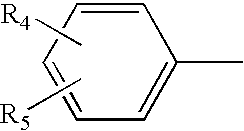Radical polymerization catalyst and adhesive kit for dental use
a technology of radioactive polymerization and adhesive kit, which is applied in the direction of physical/chemical process catalysts, impression caps, applications, etc., can solve the problems of difficult to know the exact amount of light supplied from the light irradiator, the decrease in the amount of light supplied is difficult to know, and the amount of light supplied is insufficien
- Summary
- Abstract
- Description
- Claims
- Application Information
AI Technical Summary
Benefits of technology
Problems solved by technology
Method used
Image
Examples
example 1
To 100 parts by mass of a MMA / TMPT (90 wt. % / 10 wt. %) solution were added 5 parts by mass of PM (an acidic compound) and 0.005 part by mass of VOAA (a vanadium compound) to prepare a homogeneous solution (a first solution). Separately, 3 parts by mass of PhBNa (an aryl borate compound) was added to a MMA / TMPT (90 wt. % / 10 wt. %) solution to prepare a homogeneous solution (a second solution). The two solutions were mixed at a 1:1 mass ratio until the mixture became homogeneous, after which the mixture was evaluated for curing time, curability and surface stickiness when cured. Further, the cured material was evaluated for initial color and discoloration resistance. The results are shown in Table 1.
TABLE 1Aryl borateAcidicVanadiumcompoundcompoundcompoundOtherpartspartspartadditivebybybyparts byCuringInitialResistance tomassmassmassmasstimeCurabilitycolordiscolorationExample 1PhBNa3PM5VOAA0.005——3′10″⊚11Example 2PhBNa1PM5VOAA0.005——6′40″⊚11Example 3PhBDMPT3PM5VOAA0.005——3′20″⊚12Exa...
example 20
0.005 part by mass of VOAA (a vanadium compound) was added to 200 parts by mass of PM to form a homogeneous solution. Thereto was added 3 parts by mass of PhBNa (an aryl borate compound), followed by mixing for 20 seconds. The resulting composition was evaluated for curability, initial color and discoloration resistance. As a result, the curability was ◯, the initial color was score 1, and the discoloration resistance was score 2.
example 21
There was prepared an adhesive A for direct restoration consisting of a first solution and a second solution each having a composition shown in Table 2 (the value of each component in Table 2 indicates parts by mass. The same applies in all Tables which follow.). The two solutions were mixed right before use to obtain an adhesive having compounding proportions shown in Table 2. Using this adhesive, an adhesion strength when a photo-curing type composite resin was used, was measured according to the measurement method 1 for adhesion strength. As shown in Table 3, the adhesion strength to enamel was 13.9 (2.2) MPa and the adhesion strength to dentin was 12.3 (2.6) MPa [( ) indicates a standard deviation].
TABLE 2Composition of first solutionComposition of second solutionAcidicNon-acidicVanadiumNon-acidicAryl borateOthermonomer(s)monomerscompoundmonomerscompoundcomponentsAPM25D2.6E15VOAA0.005HEMA30PhBTEOA3—TMPT10MMA17BPM25D2.6E15VOAA0.005HEMA30PhBTEOA3FASG7TMPT10MMA10CPM25D2.6E15VOAA...
PUM
| Property | Measurement | Unit |
|---|---|---|
| Fraction | aaaaa | aaaaa |
| Fraction | aaaaa | aaaaa |
| Fraction | aaaaa | aaaaa |
Abstract
Description
Claims
Application Information
 Login to View More
Login to View More - R&D
- Intellectual Property
- Life Sciences
- Materials
- Tech Scout
- Unparalleled Data Quality
- Higher Quality Content
- 60% Fewer Hallucinations
Browse by: Latest US Patents, China's latest patents, Technical Efficacy Thesaurus, Application Domain, Technology Topic, Popular Technical Reports.
© 2025 PatSnap. All rights reserved.Legal|Privacy policy|Modern Slavery Act Transparency Statement|Sitemap|About US| Contact US: help@patsnap.com



